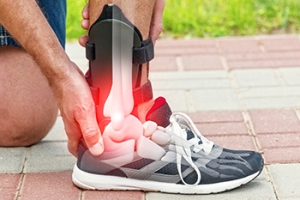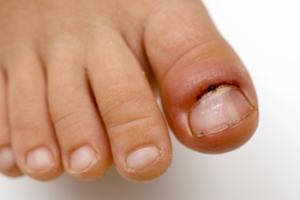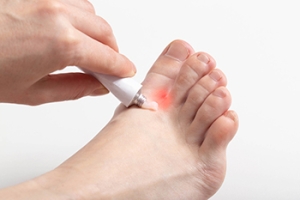
Causes and Symptoms of Poor Foot Circulation
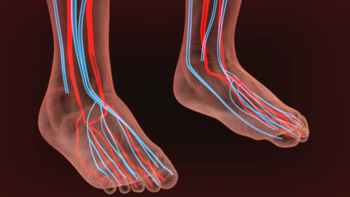
Poor foot circulation, often linked to peripheral vascular disease, or PVD, can cause significant discomfort and health issues. Symptoms can include numbness, tingling, and cold feet, in addition to noticeable changes in skin color or wounds that heal slowly. Common causes of poor circulation include diabetes, smoking, and prolonged sitting or standing. To alleviate symptoms, adopting lifestyle changes is vital. Regular exercise, such as walking or cycling, helps improve blood flow. Elevating the feet and avoiding wearing tight footwear can also enhance circulation. Additionally, quitting smoking and managing underlying conditions like diabetes contribute to better vascular health. If you have any of the above symptoms, it is strongly suggested that you promptly visit a podiatrist who can accurately diagnose and treat poor circulation.
Poor circulation is a serious condition and needs immediate medical attention. If you have any concerns with poor circulation in your feet contact Kent DiNucci, DPM of Ankle and Foot Clinic . Our doctor will treat your foot and ankle needs.
Poor Circulation in the Feet
Poor blood circulation in the feet and legs is can be caused by peripheral artery disease (PAD), which is the result of a buildup of plaque in the arteries.
Plaque buildup or atherosclerosis results from excess calcium and cholesterol in the bloodstream. This can restrict the amount of blood which can flow through the arteries. Poor blood circulation in the feet and legs are sometimes caused by inflammation in the blood vessels, known as vasculitis.
Causes
Lack of oxygen and oxygen from poor blood circulation restricts muscle growth and development. It can also cause:
- Muscle pain, stiffness, or weakness
- Numbness or cramping in the legs
- Skin discoloration
- Slower nail & hair growth
- Erectile dysfunction
Those who have diabetes or smoke are at greatest risk for poor circulation, as are those who are over 50. If you have poor circulation in the feet and legs it may be caused by PAD and is important to make changes to your lifestyle in order to reduce risk of getting a heart attack or stroke. Exercise and maintaining a healthy lifestyle will dramatically improve conditions.
As always, see a podiatrist as he or she will assist in finding a regimen that suits you. A podiatrist can also prescribe you any needed medication.
If you have any questions please feel free to contact our office located in Omaha, NE . We offer the newest diagnostic and treatment technologies for all your foot and ankle needs.
Causes, Symptoms, and Treatment of Poor Blood Circulation in the Feet
Poor blood circulation in the feet and legs is often caused by peripheral artery disease (PAD), which is usually the result of a buildup of plaque in the arteries. Plaque buildup, or atherosclerosis, can be the result of excess calcium and cholesterol in the bloodstream. This restricts how much blood can flow through arteries. Reduced blood flow to a certain area of the body severely limits the amount of oxygen and nutrients that part of the body receives. This leads to degeneration in the muscles and other tissues. Sometimes, poor blood circulation in the feet and legs can be caused by other conditions, such as the damaging or inflammation of blood vessels, known as vasculitis.
The lack of oxygen and nutrients caused by poor blood circulation can restrict muscle growth and development, as well as cause muscle pain and cramps, weakness, and stiffness. Other common symptoms include numbness in the legs and feet, skin discoloration in the affected limbs, slower nail and hair growth, and erectile dysfunction in men. In more severe cases of PAD, pain can be present even when a person isn't exercising, and may range from mildly uncomfortable to completely debilitating.
Poor blood circulation in the feet and legs is more common in those who are overweight or obese, have diabetes, high blood pressure, high cholesterol, who smoke, or who have a family history of PAD or related conditions such as a heart attack, stroke, etc. Diabetes and smoking place a person at greatest risk for developing poor blood circulation, although advanced age, over 50, can also increase risk.
If you are experiencing poor blood circulation in the feet and legs caused by PAD, it is important to make changes to your lifestyle in order to reduce your risk of experiencing a heart attack or stroke caused by this condition. If you smoke, quit completely. This will increase the amount of oxygen in your bloodstream. Exercising and reducing the saturated fats in your diet. Saturated fats come from fatty meats, fried foods, whole milk, etc., can make a difference in improving blood circulation in feet. It is also important to avoid developing influenza and to carefully control your blood sugar if you have diabetes.
Your doctor may recommend combining lifestyle changes with a prescription medication regimen to improve blood circulation. The most commonly-used medications for PAD are called statins and work by blocking the amount of enzymes in your body that produce cholesterol. They are known by the brand names Zocor, Lipitor, Crestor, and others.
Foot Orthoses
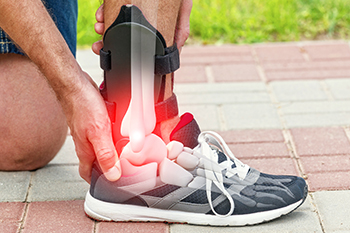 A foot orthosis, with the plural being orthoses, is a medical device inserted into shoes to correct foot problems by redistributing pressure and providing support. These devices function by adhering to tissue stress principles, which aim to reduce stress and strain on tissues within the foot, alleviating pain and promoting healing. Orthoses are used for various foot conditions, such as plantar fasciitis, Achilles tendinopathy, and midfoot osteoarthritis. Foot orthoses work by aligning the foot and ankle into a more biomechanically efficient position, thus reducing abnormal motion and pressure on specific areas. They can be either prefabricated or custom-made. Prefabricated orthoses are mass-produced and available off the shelf, offering a general fit and support. Custom-made orthoses, however, are specifically designed to match an individual's unique foot structure and condition, providing a higher level of precision and effectiveness. Proper prescription and fitting of orthoses are imperative for achieving the desired therapeutic outcomes. If you have foot pain that persists, it is suggested that you consult a podiatrist for an accurate diagnosis and to see if orthotics can help you.
A foot orthosis, with the plural being orthoses, is a medical device inserted into shoes to correct foot problems by redistributing pressure and providing support. These devices function by adhering to tissue stress principles, which aim to reduce stress and strain on tissues within the foot, alleviating pain and promoting healing. Orthoses are used for various foot conditions, such as plantar fasciitis, Achilles tendinopathy, and midfoot osteoarthritis. Foot orthoses work by aligning the foot and ankle into a more biomechanically efficient position, thus reducing abnormal motion and pressure on specific areas. They can be either prefabricated or custom-made. Prefabricated orthoses are mass-produced and available off the shelf, offering a general fit and support. Custom-made orthoses, however, are specifically designed to match an individual's unique foot structure and condition, providing a higher level of precision and effectiveness. Proper prescription and fitting of orthoses are imperative for achieving the desired therapeutic outcomes. If you have foot pain that persists, it is suggested that you consult a podiatrist for an accurate diagnosis and to see if orthotics can help you.
If you are having discomfort in your feet and would like to try orthotics, contact Kent DiNucci, DPM from Ankle and Foot Clinic . Our doctor can provide the care you need to keep you pain-free and on your feet.
What Are Orthotics?
Orthotics are inserts you can place into your shoes to help with a variety of foot problems such as flat feet or foot pain. Orthotics provide relief and comfort for minor foot and heel pain but can’t correct serious biomechanical problems in your feet.
Over-the-Counter Inserts
Orthotics come in a wide variety of over-the-counter inserts that are used to treat foot pain, heel pain, and minor problems. For example, arch supports can be inserted into your shoes to help correct overarched or flat feet, while gel insoles are often used because they provide comfort and relief from foot and heel pain by alleviating pressure.
Prescription Orthotics
If over-the-counter inserts don’t work for you or if you have a more severe foot concern, it is possible to have your podiatrist prescribe custom orthotics. These high-quality inserts are designed to treat problems such as abnormal motion, plantar fasciitis, and severe forms of heel pain. They can even be used to help patients suffering from diabetes by treating foot ulcers and painful calluses and are usually molded to your feet individually, which allows them to provide full support and comfort.
If you are experiencing minor to severe foot or heel pain, it’s recommended to speak with your podiatrist about the possibilities of using orthotics. A podiatrist can determine which type of orthotic is right for you and allow you to take the first steps towards being pain-free.
If you have any questions please contact our office located in Omaha, NE . We offer the newest diagnostic and treatment technologies for all your foot and ankle needs.
Foot Orthotics
Orthotics are shoe inserts that are meant to correct an irregular walking gait or provide cushioning to the feet. Orthotics come in a variety of different models and sizes, including over-the-counter and customizable variants. Customizable orthotics can be shaped and contoured to fit inside a specific shoe and are typically prescribed through a podiatrist who specializes in customized footwear and orthotics design and management.
Orthotics are beneficial because they can help prevent injuries from occurring and provide cushioning to keep pain levels down to a minimum. They also allow for the correct positioning of the feet. Orthotics can act as shock absorbers to help remove pressure from the foot and ankle. Therefore, orthotics can make bodily movements, such as walking and running, become more comfortable as well as help prevent the development of certain foot conditions.
Orthotics alleviate pain and make the foot more comfortable by slightly altering the angle at which the foot strikes the ground surface, therefore controlling the movement of the foot and ankle. Orthotics come in different variants and can be made of various materials. To determine what type of orthotic is most suited to your feet and your needs, it is best to consult your podiatrist. He or she will be able to recommend a type of orthotic that can help improve your foot function or prescribe a custom orthotic to best fit your feet.
What Is a Podiatrist and Why You Might Want to See One
 Podiatrists are medical professionals who specialize in diagnosing and treating conditions related to the feet, ankles, and lower extremities. They undergo extensive education and training, typically earning a Doctor of Podiatric Medicine, or DPM, degree, followed by a residency program. Podiatrists are equipped to handle a wide range of issues, from common problems like bunions, heel pain, and ingrown toenails to more complex conditions such as diabetic foot complications, fractures, and sports injuries. They utilize various diagnostic tools, including X-rays, ultrasounds, and lab tests, to accurately assess foot and ankle health. Treatment options may range from conservative approaches, like wearing orthotics and targeted stretching exercises, to surgical interventions when necessary. Podiatrists also play a critical role in preventive care, providing guidance on proper footwear, foot hygiene, and exercises to maintain foot health. If you have any foot or ankle concerns, it is suggested that you schedule an appointment with a podiatrist for care.
Podiatrists are medical professionals who specialize in diagnosing and treating conditions related to the feet, ankles, and lower extremities. They undergo extensive education and training, typically earning a Doctor of Podiatric Medicine, or DPM, degree, followed by a residency program. Podiatrists are equipped to handle a wide range of issues, from common problems like bunions, heel pain, and ingrown toenails to more complex conditions such as diabetic foot complications, fractures, and sports injuries. They utilize various diagnostic tools, including X-rays, ultrasounds, and lab tests, to accurately assess foot and ankle health. Treatment options may range from conservative approaches, like wearing orthotics and targeted stretching exercises, to surgical interventions when necessary. Podiatrists also play a critical role in preventive care, providing guidance on proper footwear, foot hygiene, and exercises to maintain foot health. If you have any foot or ankle concerns, it is suggested that you schedule an appointment with a podiatrist for care.
If you are dealing with pain in your feet and ankles, you may want to seek help from a podiatrist. Feel free to contact Kent DiNucci, DPM from Ankle and Foot Clinic . Our doctor can provide the care you need to keep you pain-free and on your feet.
What Is a Podiatrist?
A podiatrist is a doctor of podiatric medicine who diagnoses and treats conditions of the foot, ankle, and related structures of the leg. Your podiatrist may specialize in a certain field such as sports medicine, wound care, pediatrics, and diabetic care. Podiatrists have the ability to become board certified through training, clinical experience, and then taking an exam.
What Do Podiatrists Do?
On a daily basis, a podiatrist may perform the following activities:
- Diagnose foot ailments such as ulcers, tumors, fractures, etc.
- Use innovative methods to treat conditions
- Use corrective orthotics, casts, and strappings to correct deformities
- Correct walking patterns and balance
- Provide individual consultations to patients
It is very important that you take care of your feet. It’s easy to take having healthy feet for granted, however foot problems tend to be among the most common health conditions. Podiatrists can help diagnose and treat a variety of feet related conditions, so it is crucial that you visit one if you need assistance.
If you have any questions please feel free to contact our office located in Omaha, NE . We offer the newest diagnostic and treatment technologies for all your foot and ankle needs.
What is a Podiatrist?
A podiatrist is a Doctor of Podiatric Medicine who treats the foot, ankle, and related structures of the leg. If you are having any pain, injuries, or abnormalities in these areas, it is best that you seek help from a podiatrist.
Podiatrists complete four years of training in a podiatric medical school. Their training is like that of other physicians, and they may go on to complete a fellowship training after a residency training. Some podiatrists are board certified meaning they have advanced training, clinical experience, and have taken an exam to prove their skills. Certifying boards for podiatry are the American Board of Foot and Ankle Surgery and the American Board of Podiatric Medicine. Podiatrists may work in private practices, hospitals, clinics, or they may even become professors at colleges of podiatric medicine.
While in college, those who want to be podiatrists often take biology, chemistry, and physics classes in preparation for podiatry school. In podiatry school, students study how the bones, nerves, and muscles work together to help you move around. Additionally, they study injuries and how to properly diagnose and treat them. Admittance into podiatric medical school requires the completion of 90 semester hours of undergraduate study with a good grade point average, and acceptable scores on the MCAT (Medical College Admission Test)
Podiatrists treat many different conditions such as: aching feet, ankle pain, bunions, corns, hammertoes, fungus, ingrown toenails, plantar fasciitis, sprains and more. Common forms of treatment for these conditions are physical therapy, drugs, or surgery. Podiatrists may also recommend corrective shoe inserts, custom-made shoes, plaster casts, and strappings to correct deformities.
Even if you are someone whose feet are in generally good condition, you should still visit a podiatrist to have your feet properly exfoliated and maintained, or to make sure you are looking after your feet properly.
Symptoms and Causes of an Infected Toe
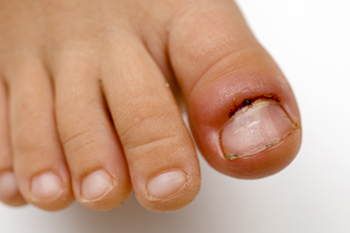
An infected toe often presents with redness, swelling, and pain, sometimes accompanied by pus or an unpleasant odor. Several factors can lead to this condition. Injuries, such as stubbing your toe or dropping something heavy on it, can create openings for bacteria. Microorganisms, including bacteria and fungi, can infiltrate these wounds or even enter through small cracks in dry skin. Natural toe growth, particularly when nails grow inward, can push into the skin and cause infection. Foot yeast infections, commonly known as athlete's foot, can also escalate into bacterial infections if not treated promptly. Additionally, individuals with diabetes are at a higher risk due to poor circulation and impaired immune response, which can make even minor infections more severe. If your toe has become infected, it is suggested that you promptly visit a podiatrist who can offer you effective treatment solutions.
Toe pain can disrupt your daily activities. If you have any concerns, contact Kent DiNucci, DPM of Ankle and Foot Clinic . Our doctor can provide the care you need to keep you pain-free and on your feet.
What Causes Toe Pain?
Most severe toe pain is caused due to a sports injury, trauma from dropping something heavy on the toe, or bumping into something rigid. Other problems can develop over time for various reasons.
Toe pain can be caused by one or more ailments. The most common include:
- Trauma
- Sports injury
- Wearing shoes that are too tight
- Arthritis
- Gout
- Corns and calluses
- Hammertoe
- Bunions
- Blisters
- Ingrown toenails
- Sprains
- Fractures (broken bones)
- Dislocations
When to See a Podiatrist
- Severe pain
- Persistent pain that lasts more than a week
- Signs of infection
- Continued swelling
- Pain that prevents walking
Diagnosis
In many cases the cause of toe pain is obvious, but in others, a podiatrist may want to use more advanced methods to determine the problem. These can range from simple visual inspections and sensation tests to X-rays and MRI scans. Prior medical history, family medical history, and any recent physical traumatic events will all be taken into consideration for a proper diagnosis.
Treatment
Treatments for toe pain and injuries vary and may include shoe inserts, padding, taping, medicines, injections, and in some cases, surgery. If you believe that you have broken a toe, please see a podiatrist as soon as possible.
If you have any questions please feel free to contact our office located in Omaha, NE . We offer the newest diagnostic tools and technology to treat your foot and ankle needs.
Toe Pain
Toe pain can originate from corns, calluses, hammertoes, and bunions, as well as ingrown toenails, sprains, fractures, and dislocations. Corns develop as the toe rubs against the inside of a shoe which causes the skin to thicken as a form of protection. A corn is typically cone-shaped and has a small, hardened spot that points inward. When a corn is pressed into the skin, the toe becomes painful. Corns usually form on the top or side of the toe. A callus is also a thickened patch of skin that generally forms on the bottom of the foot. Calluses are the result of friction from the toe rubbing against the inside of a shoe. They may also occur by walking barefoot or having flat feet. A hammertoe is a bump on the knuckle of the second toe that is produced by wearing shoes that are too short for your feet. The bony protrusion rubs against the top of the shoe causing pain and irritation. A bunion is a malformation of the big toe. The base of the big toe pushes away from the smaller toes, forcing the top of the big toe to press toward the other toes. Bunions can be hereditary, or they can result from injury to the toe joint or from wearing high heels with a narrow toe box. The toe becomes inflamed, and a bump may develop at the end of the misplaced bone. Ingrown toenails typically affect the big toe and its surrounding skin. The nail will dig into the skin and become painful. Wearing tight or narrow shoes that compress the big toe causes the nail to grow into the fleshy part of the toe. Cutting toenails incorrectly can also add to the development of an ingrown toenail. A toe sprain originates from a torn or stretched ligament. Strapping the injured toe to the toe next to it for stabilization is common. A broken or fractured toe usually occurs from trauma like dropping a heavy object on it or bumping into something extremely hard and rigid. Osteoporosis, a thinning of the bones, can also bring about toe fractures.
Any of the conditions mentioned can lead to pain and irritation. While some are more serious than others, seeking an examination and diagnosis from a podiatrist is a good idea. A podiatrist can treat each ailment and get you back on your feet again without pain.
Athlete’s Foot Relief and Prevention Tips
 Athlete's foot, or tinea pedis, is a common fungal infection affecting the skin of the feet, typically occurring between the toes. There are three main types of athlete’s foot, which are interdigital, moccasin, and vesicular. Interdigital athlete's foot typically occurs between the toes and is characterized by itching, scaling, and sometimes maceration of the skin. Moccasin athlete's foot affects the soles and sides of the feet, presenting as dry, thickened, and scaly skin that can sometimes crack. Vesicular athlete's foot features fluid-filled blisters, often appearing on the instep, and can cause intense itching and discomfort. The infection is caused by dermatophytes, which are fungi that thrive in warm, moist environments like locker rooms, public showers, and swimming pools. Risk factors include wearing tight, non-breathable footwear, sweating heavily, and walking barefoot in damp communal areas. Symptoms include itching, burning, peeling, and cracked skin, often accompanied by redness and blisters. Athlete's foot is extremely contagious and can spread through direct contact with infected skin or contaminated surfaces. Treatment involves antifungal medications, available as creams, sprays, or oral prescriptions, depending on the severity. If you have athlete’s foot, it is strongly suggested that you visit a podiatrist who can effectively treat the infection, which often includes prescribed medication.
Athlete's foot, or tinea pedis, is a common fungal infection affecting the skin of the feet, typically occurring between the toes. There are three main types of athlete’s foot, which are interdigital, moccasin, and vesicular. Interdigital athlete's foot typically occurs between the toes and is characterized by itching, scaling, and sometimes maceration of the skin. Moccasin athlete's foot affects the soles and sides of the feet, presenting as dry, thickened, and scaly skin that can sometimes crack. Vesicular athlete's foot features fluid-filled blisters, often appearing on the instep, and can cause intense itching and discomfort. The infection is caused by dermatophytes, which are fungi that thrive in warm, moist environments like locker rooms, public showers, and swimming pools. Risk factors include wearing tight, non-breathable footwear, sweating heavily, and walking barefoot in damp communal areas. Symptoms include itching, burning, peeling, and cracked skin, often accompanied by redness and blisters. Athlete's foot is extremely contagious and can spread through direct contact with infected skin or contaminated surfaces. Treatment involves antifungal medications, available as creams, sprays, or oral prescriptions, depending on the severity. If you have athlete’s foot, it is strongly suggested that you visit a podiatrist who can effectively treat the infection, which often includes prescribed medication.
Athlete’s foot is an inconvenient condition that can be easily reduced with the proper treatment. If you have any concerns about your feet and ankles, contact Kent DiNucci, DPM from Ankle and Foot Clinic . Our doctor will treat your foot and ankle needs.
Athlete’s Foot: The Sole Story
Athlete's foot, also known as tinea pedis, can be an extremely contagious foot infection. It is commonly contracted in public changing areas and bathrooms, dormitory style living quarters, around locker rooms and public swimming pools, or anywhere your feet often come into contact with other people.
Solutions to Combat Athlete’s Foot
- Hydrate your feet by using lotion
- Exfoliate
- Buff off nails
- Use of anti-fungal products
- Examine your feet and visit your doctor if any suspicious blisters or cuts develop
Athlete’s foot can cause many irritating symptoms such as dry and flaking skin, itching, and redness. Some more severe symptoms can include bleeding and cracked skin, intense itching and burning, and even pain when walking. In the worst cases, Athlete’s foot can cause blistering as well. Speak to your podiatrist for a better understanding of the different causes of Athlete’s foot, as well as help in determining which treatment options are best for you.
If you have any questions please feel free to contact our office located in Omaha, NE . We offer the newest diagnostic and treatment technologies for all your foot and ankle needs.
Athlete's Foot
Athlete’s foot is an extremely contagious infection caused by a fungus that results in itching, burning, dry, and flaking feet. The fungus that causes athlete’s foot is known as tinea pedis and thrives in moist, dark areas such as shower floors, gyms, socks and shoes, commons areas, public changing areas, bathrooms, dormitory style houses, locker rooms, and public swimming pools. Athlete’s foot is difficult to treat as well because of the highly contagious and recurrent nature of the fungus.
Tinea is the same fungus that causes ringworm, and is spread by direct contact with an infected body part, contaminated clothing, or by touching other objects and body parts that have been exposed to the fungus. Because the feet are an ideal place for tinea to grow and spread, this is the most commonly affected area. It is, however, known to grow in other places. The term athlete’s foot describes tinea that grows strictly on the feet.
The most commonly infected body parts are the hands, groin, and scalp, as well as the feet. Around 70% of the population suffer from tinea infections at some point in their lives, however not all of these cases are athlete’s foot. Just like any other ailment, some people are more likely to get it than others, such as people with a history of tinea infections or other skin infections, both recurring and non-recurring ones. The extent to which a person experiences regrowth and recurrent tinea infections varies from person to person.
Sometimes people will not even know that they are infected with tinea or that they have athlete’s foot because of a lack of symptoms. However, most experience mild to moderate flaking, itching, redness, and burning. However, some of the more severe symptoms include cracking and bleeding skin, intense itching and burning, pain while walking or standing, and even blistering.
Because of the recurring nature of the tinea fungus and the athlete’s foot it causes, the best way to treat this condition is with prevention. You can take some preventative measures such as wearing flip flops or sandals in locker rooms and public showers to reduce contact with the floor. It also helps to keep clean, dry feet while allowing them to breathe. Using powders to keep your feet dry is a good idea, as well as keeping your feet exposed to light and cool air, to prevent the growth of tinea. If you do happen to get athlete’s foot, opt for using topical medicated creams, ointments or sprays. These treatments help eliminate and prevent it from coming back.

